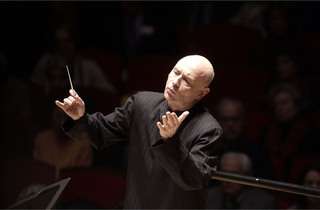|
Back
Oysters and White Wine Los Angeles
Walt Disney Concert Hall
05/30/2009 -
Wolfgang Amadeus Mozart: Symphony No. 34
Anton Bruckner: Symphony No. 7
Los Angeles Philharmonic, Christoph Eschenbach (conductor) 
C. Eschenbach (© Michael Tammaro)
Christoph Eschenbach has become a kind of dependable miracle here in Los Angeles. You can count on him, as you can count on music itself, to renew the spirit, to invigorate. He is not a principal conductor here, although it might be fabulous if he were to become a principal guest conductor someday. But he has developed a relationship with the orchestra and perhaps with the audience as well, that we now look forward to with a kind of hunger. In Hemingway’s A Movable Feast, the author recounts: "As I ate the oysters with their strong taste of the sea and their faint metallic taste that the cold white wine washed away, leaving only the sea taste and the succulent texture, and as I drank their cold liquid from each shell and washed it down with the crisp taste of the wine, I lost the empty feeling and began to be happy, and to make plans." You can expect a performance by Christoph Eschenbach to renew your spirit in the same way.
Eschenbach gave a marvelous chamber music recital with some of the Philharmonic players last week. In Dvorak’s delightful Piano Quintet, they proved a well-balanced ensemble of virtuoso soloists. Each of them offered striking performances, particularly Principal Concertmaster Martin Chalifour and Principal violist Carrie Dennis, a recent arrival from the Berlin Philharmonic. They did not have the single voice of a great quartet, but no one performer dominated either. The revelation of that evening however, was Eschenbach’s first solo piano recital in 31 years. The second half of the program featured Schubert’s final Piano Sonata (D. 960 in B-flat Major). His interpretation was a little tentative, but enormously insightful. He was markedly less aggressive and perhaps less confident, than a great pianist who does not conduct might be. But when he finished, I felt that I might give my eyeteeth to hear him play it again. After his long absence from the solo keyboard, his offering was both courageous and rewarding. We can only hope that he will return to the solo piano as often as possible.
In the first movement of Mozart’s 34th Symphony, it seemed that Eschenbach’s quick moving baton was slightly ahead of the orchestra’s response. But I would not have noticed without looking at him carefully; I would never have been able to tell from only hearing the sound. The music was fast, agile, flowing and well-blended, very nice qualities in the pinpoint Disney acoustic. By the second movement, the baton and the orchestra were in perfect visual synch. Holding the baton like a paintbrush, a sweep of his arm moved the music from the violins to the cellos. The exact closure of each phrase was essential, occasionally signaled by the gesture of turning a key in a lock with his left hand. He would hush the entire orchestra by leaning back and subtly raising both of his arms. The sound was modern but neither lush nor astringent, blended rather than acutely defined. It made me think of the painters Turner and Sargent.
The magnificent 7th Symphony of Bruckner opened with a sea of strings that was barely audible, a pianissimo that was almost unimaginable. The first oboe solo, then the horns and the flutes were so beautiful that it all but distracted me from the symphony itself. The trumpets, the blend of the flute and clarinet in a duo, the ideal tempo, the refinement of dynamic contracts, all of this in the first movement was outstanding. Eschenbach clearly has a deep sympathy for this music, and the ability to convey that insight. His conducting was deliberate and strong, instilling great confidence. There is much music that is spiritual without being overtly religious, but Bruckner is a supreme exemplar of this phenomenon. My mind inadvertently began to wander, and I began to realize that I was happy, even amid today’s myriad disasters. Bruckner invigorates the spirit, like Hemingway and his oysters. There was a brilliant crescendo, and then the room was hushed and silent in reverence.
In the opening to the second movement, the Wagner tubas were a little challenged, with a slightly ragged blend. This stood out because so much was so perfect. The falling melody in the strings was intense, as was the blast of brass in a completely different way, before the strings again, bathed in pastoral sunlight. Perfection flowed from crescendo to crescendo, to diminishing pizzicati in the violins, to flawless French horns and a flute solo, echoed by the violins. The third movement scherzo was even more thrilling. This symphony, particularly the scherzo, must be one of the most “architectural” creations in symphonic music. It may be the ultimate example of music as “flowing, or molten architecture,” to envision the opposite of Goethe’s image of architecture as frozen or silent music. The last chord of the finale rang out magnificently. Then we were all on our feet in a roar of applause.
Thomas Aujero Small
|